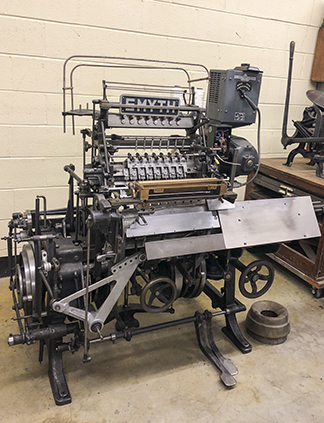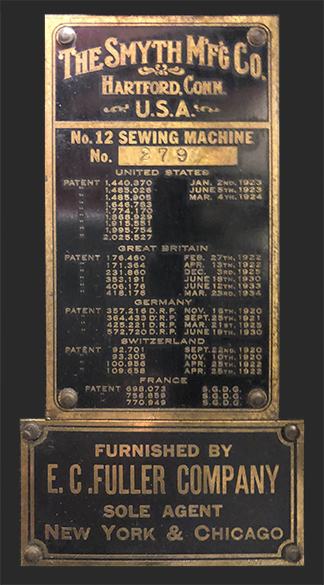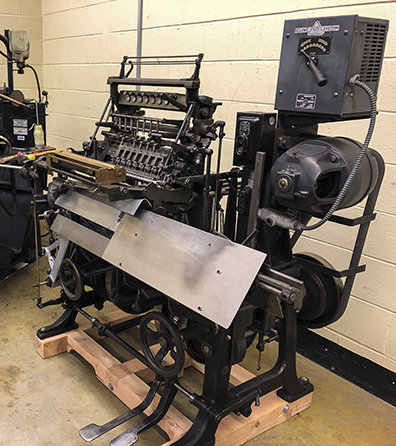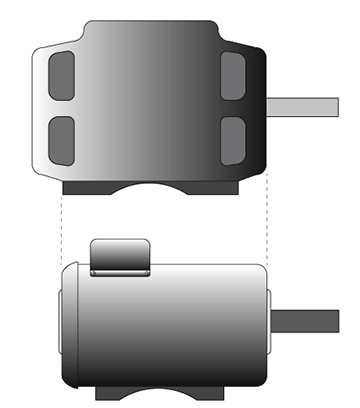I get obsessed about my projects.
My current obsession is the restoration of a 1935 Smyth book sewing machine in the Shakespeare Press Museum at Cal Poly (I was the faculty advisor before I retired). That machine sews the spines of hard-cover books. It’s a pretty good bet that every production case-bound book in the world is made with Smyth book sewing machines.

The machine in question is on very-long-term loan from the California Department of General Services. It was used for many years to bind books produced by the State Office of Printing. When they no longer needed it, they put it in a glass case in their lobby, where it sat for many years as an antique curiosity.
A few years ago I paid a drayage company a tremendous amount of money to move the machine to Cal Poly. They broke the glass case, which didn’t matter because I didn’t expect them to try to ship that with the machine and I didn’t care when it showed up in shards.
A Smyth machine weighs in at just under a ton. It’s difficult to move without damaging the machine because its many cams hang below a common main shaft that runs laterally under the machine. Lifting and moving it requires jacks and solid steel rollers. The most difficult part was getting it off of the pallet. The machine was lifted into the air with jacks and 4×4 timbers, then the pallet was taken out from underneath. Once that was done, the machine was carefully lowered onto blocks of wood on the corners by our skilled team of drayers (me).

Moving it into position was relatively easy. I used “crabs” which are small steel skateboards with solid wheels. Once in position, it had to be lifted off of the crabs, then gingerly lowered onto the floor. Dropping a machine like this – even an inch – can be fatal to the cast iron parts (for this I had help). We managed to get it to the concrete floor with long steel pry bars and ever-thinner slips of wood. The last quarter-inch was announced with a bang, but nothing was damaged.
Since the machine had been sitting for years in a glass case, it was in beautiful condition. No rust, no dust, but also no movement. The lubricants in the machine had solidified, and the mechanism was inoperative as a result. The main clutch was frozen, the delivery table gears were stuck. It was, internally, a no-go mechanism. It was also missing a couple of key parts. Two long springs are normally on the bottom of the cam followers, ending on a center foot of the machine. One of those springs was missing. I tried to order one, but couldn’t find any the correct size, so I went to McMaster-Carr in Los Angeles, and they quoted $275 for a single spring to be custom manufactured. Another custom spring maker in Los Angeles quoted $750 for one spring.
Then I called Smyth, whose headquarters had moved from the original Hartford, Connecticut home to a new facility in South Carolina. After a couple of tries, I reached Jennifer at Smyth who told me that, yes, they still stock that part (they still use the same part in modern Smyth machines). Yes I could order one, but, she cautioned me, “We have a $25 minimum order.” She suggested that I buy two of the springs at $7.95 each, and then buy something else that I might need for the machine. I bought 100 needles and 100 crochet hooks, and two springs, and I spent about $125.00. I am now outfitted for the next decade for needles and hooks. The springs fit perfectly; I had them installed in minutes.
Getting the machine turning was more challenging. The State Printing Office sent a technician to San Luis Obispo to help (it is their machine, after all). He was successful in getting the main clutch turning again, and he and I got the main shaft turning. My friend Bill and I got the feed table gears freed-up with lots of back-and-forth and a lot of penetrating oil. Now it’s moving smoothly again.

The original motor, a 1/2 HP Westinghouse 208 volt 3-phase motor was not in good condition, so I decided to scrap it and start over on motive power. And therein lies the root of my current obsession. The original motor had a speed control that was made in 1935. That speed control consists of huge wire-wound resistors with multiple taps in the middle, connected to a series of copper contacts that are touched by a rotating lever on the control panel. It was old and it no longer worked correctly. The technician from the State Printing Office also said it was dangerous (large exposed live electrical contacts), so the decision to replace it was easier. I always strive for historic accuracy, but in this case I chose safety over authenticity. The machine itself is still historically accurate.
I decided to replace the motor with a modern 1 HP 3-phase sealed and fan-cooled motor. These are common and easy to install and connect. The problem was the speed control. The motor I bought runs at 1340 rpm – only. I need something much slower for this machine, probably 500 rpm, or perhaps less.

On machines of this type it’s common to see mechanical variable-speed pulleys (our Heidelberg Windmill press has this type of speed control). I couldn’t use that because the main clutch is encased inside the main flywheel, which is also the main drive wheel. There is no practical way to engineer this without making a secondary pulley system; that was too complicated. So I decided to use an electronic motor speed control instead, and that is covered in the next part of this story. Read about the wiring and the utility box, and the Variable-Frequency Drive.
Addendum November 1, 2025: I have scanned and published a draft of the 1935 Smyth Instruction and Parts Manual. It can be downloaded here.

I owned and worked on those sewing machines for 40 years. if you need some help or advice, I’ll gladly help you. Joseph
Hi Joseph,
I might call on you for advice at some point. I’m working in Germany for a year and will not be back in the company of the Smyth until I return. There is one problem I am having with the clutch where your input might be needed.
Best wishes,
Brian P. Lawler
The Blognosticator
Joseph,
Do you have any leads on purchasing a Smyth machine?
Best and thanks,
Stephen
Hi Stephen,
That’s an interesting question. I have never looked for one, but I’ll bet they show up on eBay from time to time. There are also used printing machinery dealers around who might have one for sale.
I’m always surprised by the availability of parts and supplies for these old machines. I wouldn’t surprise me if there were machines in the back shops of printers around the country. I would start with an inquiry to Smyth. Their e-mail is: support@smythusa.com.
They may be able to direct you to a used machine.
Best wishes,
Brian P. Lawler
Thanks for your reply, Brian. I appreciate it.
hi Joseph –
I came upon a No. 10 which has been taken apart and I’m trying to figure out if it’s a workable machine.
Dear Markus,
A disassembled Smyth machine could be a real mess! It’s a very complicated machine, and it might be difficult to get it back together again.
Ours was in “working” condition when it arrived. It had been in a display case for 20 years prior to be donated to our museum. It was running when it went into the display case, but it was definitely NOT running when it came out.
I had to loosen up all the moving parts, as its lubricants had hardened into waxy goo, and that was very difficult. I also had to completely rebuild the clutch mechanism, which was surprisingly easy to do. It required some specialty tools (a big gear-puller and a couple of unique pin spanners), but once I had it off the machine, it was easy to see how it works, and how to get it back together in working condition.
It took a couple of days to restore the clutch, but eventually I had it back on and running again. It’s a lovely system, and well-designed. I am impressed that a machine built in the late 1930s can still work as well as this machine does. I was stitching books just a week ago!
It could be used for production today, as it’s in top shape now. I regret that I don’t have enough work to keep it running more often.
Best wishes,
Brian P. Lawler
The Blognosticator
hi Brian, yes… If it were assembled, I’d jump on it in a heartbeat. I’m pretty mechanical, but without any documentation – or possibly a machine to compare it to, it’s a pretty hopless case.
Hi Brian and Stephen,
Ran across this post looking for other things printing related. Just wanted to make sure you are aware of Howard Graphic Equipment and the printing museum that Nick Howard and his family own and operate in Ontario, Canada. They restore all kinds of equipment and might have leads that can help you. Check out http://howardironworks.org/
Cheers Gentlemen! Wish you the very best! Ted
Hi Ted,
I just recently learned about the Howard museum. I watched a video on YouTube about it. That’s an impressive collection, and I will one day visit!
Thank you,
Brian P. Lawler
The Blognosticator
Hi,
I saw the conversation about Symth sewing machines. It happens that I am helping my father, who’s now 77 years old to sew his old machines. Here’s a link to the ad I posted today on eBay.
https://www.ebay.com/itm/315500027332?mkcid=16&mkevt=1&mkrid=711-127632-2357-0&ssspo=dpVTQIV7TES&sssrc=2047675&ssuid=dpVTQIV7TES&widget_ver=artemis&media=COPY
Feel free to reach out to me with any inquiries!
~Toni
Hi Toni,
I think you must have meant that you’re helping him SELL his old machines. If they are in working order, these Smyth machines are valuable (Smyth still makes them and sells them internationally, but they are VERY expensive and VERY complex).
The photos you put in the eBay ad show a machine in apparently good condition, and probably close to working condition. I suspect that you will find a buyer.
The machine I restored might be a bit older than the machine in your ad. The nameplate on the left side of the machine will show its manufacturing date and serial number. It might be nice to add those details to your eBay description.
Best of luck in selling these machines. They are wonderful devices! And, you can still get parts from Smyth to repair them (most of the time).
Sincerely,
Brian P. Lawler
The Blognosticator
Hi, I’ve a Smyth 14 that I know runs, but finding someone to describe how to set it up and operate it has proven difficult. Commercial bookbinders I’ve met who own these either aren’t willing to share information or more likely, they haven’t the time. The manual I have isn’t much help either. I only discovered this blog post by accident (searching for information on a Marshall (Manual) Rounder/Backer Machine). I’m hoping to put it to use someday soon, but it’s currently in storage in another state.
Grateful for you sharing this post and the comments above.
Terrence
Hi Terrence,
Thank you for your note. Ours is a Model 12, which is probably 25 years older than yours. But – they are almost the same.
I’m currently in the middle of rebuilding the needles/punches/crochet hooks part of our machine, and I am making progress.
I had it sewing a month ago, but it slipped and reverted to an earlier condition. I broke a needle and two crochet hooks in two seconds. That set me back.
I know the machine pretty well. I have restored ours almost completely. I took the pasting unit off completely, as we will never use that. And I decided to remove the pedal that activates the paster.
I have a lot of experience with the clutch and drive mechanism, as described in my blogs here, and I have done a lot of work to get ours running smoothly.
I agree that the manual isn’t very helpful. I have been reading mine a lot recently, trying to glean information about the threading, tensioning and positioning of parts.
It is a complicated machine, but when you get it going, it will run well.
Please let me know when you are closer to making it go, and I can probably help you.
Best wishes,
Brian P. Lawler
The Blognosticator
Sir thanks and pleasure for me to accept as friend.
We are supplier needles and parts for book sewing machine.
For more details plz log in http://www.devneedles.com
http://Www.booksewings.com
My whatsApp no is 00919825415978
Thanks
Normally I wouldn’t approve a comment from a supplier, but in this case we will be doing a favor to the bookbinding community.
Thank you for making our readers aware of your company.
Brian P. Lawler
Brian, we purchased a used but supposedly working Smyth 12 from an Amish bindery back east early this year and have been trying to restore it here at our Monastery for several months, running into frustrating problems like your own.
Is there any chance we can speak with you about our problems? I would be even more interested to be put in touch with Joseph Heimlich, one of your first commenters, who mentioned that he had worked on the machines for 40 years and was available for assistance.
Sincerely,
Bishop Auxentios
St Gregory Palamas Monastery
Etna, CA
Hi Brian, I can’t find the thread where I ask you for a pdf. so I’m starting a new one. I actually found an old manual, but it’s missing the first 6 pages. If I could just get that from you, that would be fantastic. I’m trying to find where the presser plate adjustment knob is and it’s in those first 6 pages. I have a No. 18 though. There are a few differences.
Hi Beverly,
I’ll try to do that today.
I’m off to run the Smyth as I type this. Should be an interesting day.
Brian